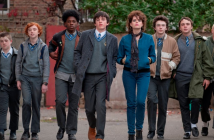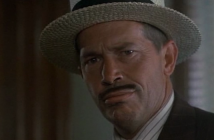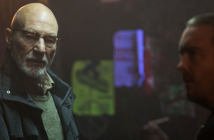High-Rise (2015)
Cast: Tom Hiddleston, Jeremy Irons, Sienna Miller
Director: Ben Wheatley
Country: UK
Genre: Action | Drama | Sci-Fi | Thriller
Editor’s Notes: The following review is part of our coverage of the Toronto International Film Festival. For more information visit tiff.net and follow TIFF on Twitter at @TIFF_NET.
A good writer leaves a lot for a reader’s imagination to let them parse the narrative vision in their own way. A good director doesn’t coddle their audiences either. They are highly aware that there are two cinemas you must consider: the screen they present their viewer with, and the screen within the viewer’s mind. In the case of Ben Wheatley’s High-Rise, there are many stories to consider. First off, how does a filmmaker even begin to envision J.G. Ballard’s dystopian tale of a society living in a building totally closed off from the outside world?
The first image we see of Tom Hiddleston as Dr. Laing is blood spattered as a result of his living in enclosed and eccentric surroundings. He flashes back to the time he first moves into his tiny apartment among the already chaotic masses. There are his downstairs neighbors: filmmaker and predator Wilder (Luke Evans) with angst-driven Helen (Elizabeth Moss). The woman upstairs is the free and beautiful Charlotte (Sienna Miller). They all live under a class system where the bottom levels are the poorest, families are in the middle, and at the top are the upscale rich. The highest level is given to the architect, Anthony Royal, played deliciously and in a way obviously, by Jeremy Irons.
…High-Rise’s sleek aesthetics are a viable component of the film infusing it with the tension and quirkiness it so richly deserves.
There are odd dance sequences, battles throughout the complex, and chaos eventually reigns, but very little is done to alert the authorities. It’s reminiscent of Bong Joo-ho’s Snowpiercer with its claustrophobic societal analogies. However, High-Rise’s sleek aesthetics are a viable component of the film infusing it with the tension and quirkiness it so richly deserves.
Set in 1975, the lens grounds itself in that era with retro yellows, oranges and browns. Crisp lines and shiny interiors offer a Kubrick-like eerie feel while the run down areas feel homier, like dated shag carpet. The homes are packed and cluttered on the lower floors while the upper floors are fancy and extravagant. The signs of war and general dissent are shown in the aftermath as bodies pile up in public spaces and absurd scenes become the norm.
While Wheatley’s A Field In England was a bit of an acid trip, this film is a like a psychedelically infused play set in an M.C. Escher etching. The caste system is in the framework, but the building’s internal geography is an interesting maze where disorder lies in every corner. The novel showcases the architecture not just of how the tenants of the building fail, but how they fall because they rely on the building to sustain them. Technological dependence is no advancement to the illogical here.
…this film is a like a psychedelically infused play set in an M.C. Escher etching.
Hiddleston plays it both raw and cool as Dr. Laing. His devolution is foreseen from the get-go and his journey percolates into a rhythmically fueled sensuality. It’s fascinating to watch.
Amy Jump and Ben Wheatley have written an adaptation from a great book and made something new and beautiful from it. There are situations that seem to go nowhere, come from the ether, or lurk in the dark. These are places where viewers are forced to do internal double takes in their brains to render the familiar walls and pillars that hold up their own dream/nightmare-like buildings. This film has cult written all over it and I loved it.
Amy Jump and Ben Wheatley have written an adaptation from a great book and made something new and beautiful from it. This film has cult written all over it and I loved it.





Pingback: free instagram followers fast and easy()
Pingback: http://www.thereadinghour.com/index.php/component/k2/itemlist/user/30775()
Pingback: https://www.youtube.com/watch?v=kFAyImX-PQA()
Pingback: geld verdienen als webcam model()
Pingback: guitar picks()
Pingback: banheiras()
Pingback: groupon gift card 25()
Pingback: Green SEO Writing()
Pingback: the raspberry diet()
Pingback: esta()
Pingback: More hints()
Pingback: Visit Website()
Pingback: Gregorio Hartill()
Pingback: Enlarged prostate supplement()
Pingback: ecograf 4D()
Pingback: Best buy iPhone Samsung accessories()
Pingback: Leaflet design()
Pingback: curso de detetive()
Pingback: paintless dent repair training()
Pingback: plumbing repair Cherry Creek()
Pingback: movie2k()
Pingback: ramalan bintang scorpio()
Pingback: email validation()
Pingback: short movie()
Pingback: online casino bonus�()
Pingback: Emails Extractor Private()
Pingback: minneapolis pay per click()
Pingback: apple shooter games()
Pingback: pillow pet()
Pingback: onion creek plumber()
Pingback: I thought about this()
Pingback: th9 war base()
Pingback: best restaurant nottingham()
Pingback: CAT-5 installer()
Pingback: this link()
Pingback: Adipex()
Pingback: Termite Treatment Perth()
Pingback: hotels in galveston tx()
Pingback: blackjack()
Pingback: at here()
Pingback: hair growth stimulation()
Pingback: bidding sites()
Pingback: what are semi permanent eyelash extensions()
Pingback: vitamin c serum()
Pingback: L’Mage Advanced Moisturizing Complex()
Pingback: CANON PIXMA iP100 Driver Free()
Pingback: Cakes To Hyderabad()
Pingback: entertainment()
Pingback: 3m window tint austin()
Pingback: Tampa Bail Bonds()
Pingback: Enea Angelo Trevisan()
Pingback: product review()
Pingback: Whitney()
Pingback: Donny Hamstra()
Pingback: Ace Roofing - Residential Roofing Company()
Pingback: tenerife blog()
Pingback: http://waterdamagerestoration-austin.com/()
Pingback: boom beach hacks()
Pingback: facebook personalities()
Pingback: singing monsters cheats()
Pingback: boom beach hack no survey()
Pingback: pest control cibolo tx()
Pingback: Вольт шоп()
Pingback: Simple Drawing For Kids()
Pingback: Hotel Di Depok()
Pingback: guitar picks()
Pingback: Hotel Di Depok()
Pingback: Healthy eating busy schedule()
Pingback: antispam e.v.()
Pingback: leaflet printing()
Pingback: popcorn rental singapore()
Pingback: second hand clothes wholesale()
Pingback: best()
Pingback: agencia publicidad malaga()
Pingback: primo water pump()
Pingback: security camera()
Pingback: Marvelous Designer how to video()
Pingback: water heater repair circle c()
Pingback: Zofia()
Pingback: best digital marketing agency()
Pingback: lovetts lovin pet and home care()
Pingback: top notch cat kennel()
Pingback: new homes in austin()
Pingback: carpet cleaning austin tx()
Pingback: monitor my childs phone()
Pingback: web design agency()
Pingback: Isagenix Retail()
Pingback: Free Marvelous Designer texturing tutorial()
Pingback: Microcap Magazine()
Pingback: Acting()
Pingback: How To Get A Girl To Like You()
Pingback: natural cure for acid reflux()
Pingback: salary tax calculator()
Pingback: lights that change color for car()
Pingback: GPS Tracker()
Pingback: white kidney bean extract faqs()
Pingback: How to Get Money Online()
Pingback: Kandace()
Pingback: exercise()
Pingback: weight loss()
Pingback: ollas rena ware()
Pingback: Complete Instamate Review()
Pingback: diabetes()
Pingback: Best laser hair removal nyc()
Pingback: real estate brokerage Clearwater()
Pingback: tv antennas worcester massachusetts()
Pingback: how make money online()
Pingback: sticky notes windows font()
Pingback: boars hair dart boards()
Pingback: highend romper()
Pingback: Cash 4 Clothes()
Pingback: punta cana gran bahia principe turquesa()
Pingback: IATA Pet Carrier in Sri Lanka()
Pingback: Security door installation()
Pingback: food places near me()
Pingback: العاب فلاش()
Pingback: tenerife estate agents()
Pingback: Clean Chocolate()
Pingback: Cleaning Quotes NZ()
Pingback: skull ring, stackable gold ring()
Pingback: cerrajero elche()
Pingback: tenerife forum()
Pingback: Accelerated Mobile pages()
Pingback: Discover More Here()
Pingback: le dernier chasseur de sorcières(The Last Witch Hunter en streaming)()
Pingback: best mattresses 2016()
Pingback: fly swatter 3d model()
Pingback: pocket sofa couch arm rest organizer()
Pingback: cat boarding naples()
Pingback: Website Templates()
Pingback: Judge Porteous Impeachment Trial Day 1 Robert G Creely()
Pingback: mobile strike hack()
Pingback: طراحی سایت()
Pingback: Better Call Saul streaming gratuit()
Pingback: carpet cleaning Austin()
Pingback: Jeanett Villafane()
Pingback: workout()
Pingback: duckbill check valve water flood diffuser()
Pingback: Plano Plastic Surgeon()
Pingback: hard drive shredding()
Pingback: my website()
Pingback: Obama student loan forgiveness()
Pingback: USA Box Express()
Pingback: fashion()
Pingback: https://www.facebook.com/sexiercom/()
Pingback: sound active strobe lights()
Pingback: Best Seller Bodybuilding muscle Stringer vest()
Pingback: one year bullshit fraud investigations()
Pingback: Desi Photographer()
Pingback: canlı casino oynananbahissiteleri()
Pingback: overnight dog care naples()
Pingback: comptable strasbourg()
Pingback: InstallShield performance()
Pingback: Startups Meet()
Pingback: dog walker naples florida()
Pingback: crossfit()
Pingback: aaronbowell()
Pingback: doggy dans online dog trainer review()
Pingback: Brooklyn Body Shop()
Pingback: Doug Cotter()
Pingback: lovetts lovin pet care()
Pingback: porno()
Pingback: All Area Over Head()
Pingback: iOS 9.3 Jailbreak()
Pingback: Decorative Concrete of Austin - Stained Concrete Flooring()
Pingback: st johns wort depression()
Pingback: fashion tips()
Pingback: Kathleen()
Pingback: geil sex date()
Pingback: learn from jon()
Pingback: Los Angeles Limo Ride()
Pingback: proxy list()
Pingback: hilarious jokes()
Pingback: over at this website()
Pingback: Limo Vancouver BC()
Pingback: over at this website()
Pingback: detox smoothies()
Pingback: candy saga()
Pingback: http://www.toprubbishclearance.co.uk/rubbish-clearance-services-united-kingdom_brockley-lewisham-se4.html()
Pingback: Phenq()
Pingback: best pill for weight loss()
Pingback: logo design sydney()
Pingback: clash royale generator online()
Pingback: psychic source customer reviews()
Pingback: porno espa�o()
Pingback: resignation letter sample()
Pingback: printingvip.com()
Pingback: SEO Norway()
Pingback: multilingual digital marketing()
Pingback: no credit check loans()
Pingback: http://pintupartisilipat.bravesites.com()
Pingback: SunTrust Online Banking Login()
Pingback: UK Casino Online()
Pingback: Whip()
Pingback: Washington DC Photographer()
Pingback: free psychic readings()
Pingback: adult shops()
Pingback: this website()
Pingback: sprei murah()
Pingback: Urgent care()
Pingback: pocket square()
Pingback: Fleshlight australia()
Pingback: best hair brush straightener()
Pingback: Sacramento compounding pharmacy()
Pingback: Witchcraft Reading group()
Pingback: yabanci bahis siteleri()
Pingback: jobs for nurses in us()
Pingback: awake dating()
Pingback: freelance illustrator()
Pingback: irrigation systems Tulsa()
Pingback: boobcritic()
Pingback: wedding tuxedos()
Pingback: Netflix Login()
Pingback: Candlewyck Cove Resort()
Pingback: propane fire pit()
Pingback: Synergyspanish()
Pingback: verhuisservice rotterdam()
Pingback: best identity theft protection()
Pingback: Red Smoothie Detox Factor Review()
Pingback: edarling()
Pingback: Hulu Login()
Pingback: neuradyne()
Pingback: http://bit.ly/1NFe4FG()
Pingback: best home air purifier for pets()
Pingback: Satta Matka()
Pingback: Coachella()
Pingback: gravesend()